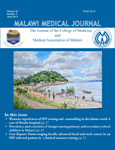
|
Malawi Medical Journal
College of Medicine, University of Malawi and Medical Association of Malawi
ISSN: 1995-7262
Vol. 19, No. 1, 2007, pp. 11-15
|
 Bioline Code: mm07003
Bioline Code: mm07003
Full paper language: English
Document type: Research Article
Document available free of charge
|
|
|
Malawi Medical Journal, Vol. 19, No. 1, 2007, pp. 11-15
| en |
In-vivo parasitological response to sulfadoxinepyrimethamine in pregnant women in southern Malawi
Msyamboza, K.; Amanor, A.; Kazembe, P.; Brabin, B.J.; Meshnick, S. & Mwapasa, V.
Abstract
Background: Malaria in pregnancy is a significant cause of maternal and infant morbidity and mortality. Malawi adopted intermittent preventive treatment with sulfadoxinepyrimethamine (SP) for the control of malaria in pregnancy in 1993. However there is little information on the in-vivo
SP efficacy in pregnant women. This study was conducted to determine: prevalence of malaria and anaemia at the first antenatal visit and rate of parasitological failure to SP in pregnancy.
Methods: A cross-sectional followed by a prospective cohort study was conducted in women attending antenatal care clinic at Montfort Hospital in Lower Shire Valley from June 2004 to February 2005. Women were screened for malaria and anaemia at the first antenatal visit. After taking SP under direct observation, women with malaria parasitaemia were followed up to day 14 to determine parasitological response.
Results: Of 961 women screened, 9% had malaria, 77% had anaemia (HB<11.0g/dl), 24% had moderate anaemia (HB 7.0-8.9g/dl) and 6% had severe anaemia (HB<7.0g/dl). Malaria was significantly more frequent in primigravidae, the second trimester and in the post- rainy season (all p <0.05).
Moderate anaemia (Hb < 9.0g/dl) was significantly more common in adolescents and primigravidae (both p <0.05). In the14-day follow up study, loss to follow up was 13%. Of the 74 women who completed the follow up, 89% cleared malaria parasites successfully and 11% had parasitological failure. Parasitological failures were all of the R1 type except for one with R2 failure.
Conclusion: Anaemia prevalence was high at first antenatal visit in this population. Rate of parasitological failure to SP in pregnancy increased from 5% in 1996 to 11% in 2004.
Keywords
Parasitology
|
| |
© Malawi Medical Journal
Alternative site location: http://revista.uft.edu.br/index.php/jbb/index
|
|
